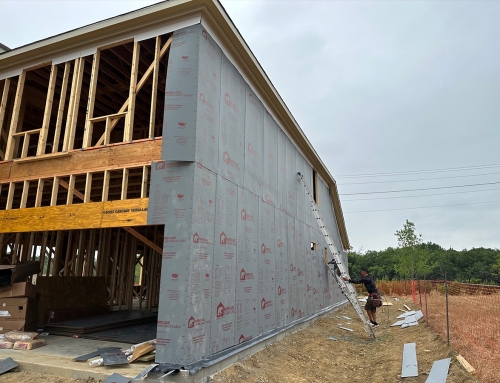Added expenses and burdens to a construction project may occur if a house wrap is improperly installed, overexposed to outside elements, or damaged and not repaired. Furthermore, applying cladding over improperly installed or ripped and torn house wrap creates drafty buildings with moisture problems.
These buildings are also less energy-efficient, durable and healthy than a building with a properly installed and undamaged house wrap.
To avoid added costs and repairs to a building project, along with future problems and expensive energy bills, it is vital to professionally and correctly install a high-quality house wrap, like Barricade® Building Wrap.
House Wrap Installation Requires a Highly Qualified Professional
A trained and qualified professional will appropriately install house wrap and ensure an energy-efficient, durable, and healthy building. A quality professional will follow manufacturer’s recommendations for house wrap application, minimize the house wraps exposure to outside elements, and thoroughly inspect for damage before cladding is applied.
Problems with house wrap can occur if the contractor improperly installs house wrap, leaves the wrap overexposed to the sun, or fails to precisely inspect the house wrap and repair problems before applying the cladding.
Improper Installation of House Wrap Creates Added Costs and Burdens
Proper and professional installation of a high-quality house wrap is vital to its performance and creating an energy-efficient, durable, and healthy building. When installing house wrap, several steps require special care to avoid the diminished performance of the house wrap.
- It is essential to seal the house wrap seams effectively to avoid air leakage. Sealing house wrap joints with manufacturer’s tape can raise the wrap’s performance by about 20 percent.
- It is critical for airtightness to use the manufacturer’s stapling nails or nails designed to hold down house wrap material. Also, use at least 1-inch long nails and space 12 to 18 inches on-center.
- Proper overlapping of roles of house wrap is key to stopping air leakage. Overlap and seal vertical seams by a minimum of 6 inches. Overlap and seal horizontal seams by a minimum of 4 inches.
- To further avoid air leakage, the house wrap should wrap up and over the top plate.
Barricade Building Wrap has the Integrity to Resist Installation Problems
Correct and professional installation of a high-quality house wrap, like Barricade Building Wrap, is critical to its performance and creating an energy-efficient, durable, and healthy building. Barricade Building Wrap lessens installation problems because it is strong and simple to install, which limits damage before, during and after installation.
Furthermore, Barricade Building Wrap has a vapor permeability of 11 US perms. If moisture gets into the wall system, Barricade Building Wrap allows the water vapor to escape the wall system. The integrity, permeability, and ease of applications of Barricade Building Wrap give builders the chance to avoid construction defects that add expenses and burdens.
Overexposure of House Wrap to Outside Elements Creates Added Expenses and Burdens to a Building Project
A house wrap that is left overexposed to the sun’s ultraviolet (UV) rays, either before or after installation can photodegrade, discolor, and loss tensile strength and water repellency. Furthermore, if a house wrap is not resistant to cold, it may crack at low temperatures.
Barricade Building Wrap Resists Damage from Outside Elements

To minimize problems with house wrap due to UV exposure and cold temperatures, contractors should choose a house wrap that can endure maximum exposure time to the sun and cold temperatures, like the Barricade Building Wrap. Barricade Building Wrap can withstand 12 months UV-exposure without damage occurring. Barricade Building Wrap is also temperature resistant (AC38 Section 3.3.4: (Cold Mandrel Bend Test)) and won’t crack at low temperatures.
Sloppy or Lack of Detailed House Wrap Inspections and Repairs Creates Added Expenses and Burdens to a Building Project

During the application of house wrap, daily inspections and prompt repair of any defect are critical to the performance of house wrap. Not repairing the tears, cuts, or rips in the house wrap that occur during installation will cause air leaks. It is vital to seal the damaged house wrap with code-approved contractor sheathing tape before covering with cladding.
Repair of larger tears in house wrap requires a taped 6-inch overlap of house wrap. Detailed inspection and repair of the house wrap before application of cladding are critical to successful performance of the house wrap.
A good contractor will also inspect the work of subcontractors to ensure any through-wall penetrations, such as pipes, ventilation hoods, electric boxes, conduits, etc. are correctly flashed and detailed to create an airtight and watertight seal. A less than thorough inspection of house wrap for damage or poor workmanship can add cost and burden to a construction project.
To Avoid Construction Defects that Add Expenses and Burdens Utilize Barricade Building Wrap
To minimize damage to house wrap due during construction, builders should select a house wrap with superior resistance to tearing, like Barricade® Building Wrap. Barricade Building Wrap has a tear-stop design with superb strength (tensile strength (ASTM D-5034) of 63.3 lbs/inch MD, 51.4 lbs/inch CD).
A house wrap that is improperly installed, overexposed to the sun, or damaged and not repaired will added expenses and burdens to a construction project. Consequently, if the cladding is applied over improperly installed or damaged house wrap, the building is less energy-efficient, durable and healthy.
To avoid additional expense and repairs to a building project, along with future problems and costly energy and maintenance bills, it is crucial to professionally and properly install a high-quality house wrap, like Barricade Building Wrap.







